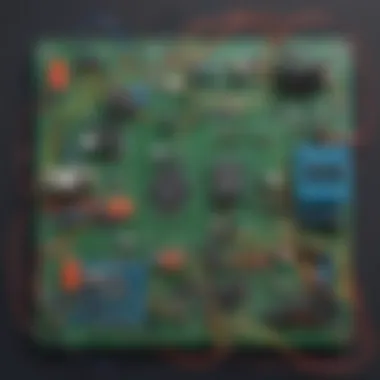Engage Young Minds with Fascinating Electrical Projects for Kids


Science Fun Facts
Have you ever wondered how electricity powers the devices we use every day? It's quite a fascinating process! Imagine electrons traveling through wires, bringing light to our homes and making our toys work. These little particles are like messengers carrying energy from one place to another. Isn't that an electrifying concept? Sometimes, electricity can even create a spark when it jumps from one surface to another. It's like a tiny lightning bolt!
Discover the Wonders of Science
As we embark on this journey of simple electrical projects for kids, we will unveil the secrets of circuits and electricity. Through engaging videos and interactive tools, we will delve into the practical applications of science in our daily lives. Picture a world where light bulbs glow, buzzers buzz, and motors spin - all thanks to the magic of electricity! Let's explore these wonders together and unlock the door to a realm of scientific discovery.
Science Quiz Time
Are you ready to test your knowledge of electricity and circuits? Get ready for some brain-teasing questions and puzzling quizzes that will challenge your understanding of science. Do you know what happens when you connect a wire to a battery? Or how to make a bulb light up using simple materials? Put on your thinking caps and get ready to unravel the mysteries of electrical circuits through fun and interactive quizzes!
Science Experiment Showcase
Let's get hands-on with some fun and engaging experiments! From building a simple circuit to creating a homemade flashlight, we will explore the magic of electricity step by step. Prepare your materials, follow the instructions carefully, and remember to prioritize safety at all times. With these experiments, you will not only learn about circuits but also develop valuable skills in problem-solving and creativity. Get ready to embark on an electrifying journey of discovery!
Introduction to Electrical Projects
Electricity is a fascinating aspect of our world and understanding its basics is essential, even for the youngest minds. In this article, we delve into the realm of electrical projects tailored for children aged 6-12. These projects not only serve as a fun way to spark curiosity but also form the foundation for a deeper understanding of circuits and electricity. By engaging in hands-on activities, children can explore fundamental concepts in an interactive manner, laying the groundwork for future STEM interests.
Understanding Electricity Basics
Introduction to circuits
Circuits are the building blocks of electrical systems. In our exploration of circuits, we will unravel their role in completing an electrical pathway. Understanding how electrons travel through a circuit is crucial in comprehending the functioning of various electrical devices. By grasping the fundamentals of circuits, children can begin to appreciate the interconnected nature of electrical components, setting the stage for more complex projects down the line.
Electricity flow
Electricity flow is the movement of electrons within a circuit. By learning about electricity flow, children gain insight into how energy is transmitted from a source to a device, powering everyday gadgets. Exploring the concept of electricity flow helps young learners visualize the dynamic process of energy transfer, leading to a deeper appreciation of power generation and consumption.
Types of circuits
Different circuits exhibit distinct characteristics, influencing their applications in various electronic systems. By examining different types of circuits such as series and parallel circuits, children can discern the strengths and limitations of each configuration. Recognizing the versatility of circuit types allows young minds to tailor their projects based on desired outcomes, fostering adaptability and problem-solving skills.


Importance of Electrical Safety
Basic safety rules
Safety is paramount when engaging in any electrical activity. Teaching children basic safety rules such as never handling electrical components with wet hands or switching off power before circuit assembly instills a culture of caution and responsibility. By prioritizing safety from the outset, children learn to mitigate risks and approach electrical projects with a mindful attitude, ensuring a safe and enjoyable learning experience.
Use of personal protective equipment
Incorporating personal protective equipment (PPE) like insulated gloves or safety goggles safeguards against potential hazards during project execution. Reinforcing the importance of PPE instills a sense of preparedness and reinforces the significance of proactive safety measures. By familiarizing children with PPE usage, caregivers empower them to prioritize their well-being while actively engaging in hands-on experiments.
Adult supervision importance
Adult supervision serves as an additional layer of protection, offering guidance and support throughout the project. Adults play a pivotal role in modeling safe practices, addressing queries, and facilitating a conducive learning environment. By emphasizing the importance of adult supervision, children benefit from expert oversight, nurturing their confidence and competence in electrical project endeavors.
Simple Electrical Projects for Beginners
Exploring simple electrical projects for beginners is a crucial stepping stone in this comprehensive guide geared towards teaching children aged 6-12 about fundamental electrical concepts. By engaging in these hands-on activities, young learners can cultivate a practical understanding of circuits and electricity. Such projects serve as an interactive platform for children to grasp the basics of electrical workings while fostering a sense of creativity and curiosity. Introducing kids to simple electrical projects early on paves the way for a more profound comprehension of scientific principles in the future.
Light Bulb Circuit
Materials required
Delving into the materials required for the light bulb circuit, we encounter essential components that form the crux of this project. The requisite items include a light bulb, wires, a battery, and a switch. Each element contributes uniquely to the functionality of the circuit. The choice of these specific materials is strategic, offering a practical and tangible experience for children to understand the basic principles of electricity. The simplicity and readily available nature of these materials make them ideal for demonstrating the functioning of a basic electrical circuit, thus enhancing the learning process.
Step-by-step instructions
Turning our attention to the step-by-step instructions for the light bulb circuit, we find a structured approach to constructing the circuit. Beginning with connecting the wires to the battery, followed by incorporating the switch and light bulb, the process unfolds sequentially to create a functional circuit. Each step is meticulously outlined to ensure clarity and understanding for young participants. The detailed instructions guide children through the circuit-building process, imparting valuable hands-on experience and reinforcing theoretical knowledge in a practical setting.
Explanation of circuit
The explanation of the circuit sheds light on the inner workings of the electrical setup. By elucidating how electricity flows from the battery, through the components, and back, children grasp the concept of a closed circuit and the role each part plays in the process. The lucid explanation simplifies complex electrical notions into digestible information, fostering a deeper comprehension of circuitry. Understanding the circuit's operation instills a sense of accomplishment and curiosity in young learners, setting the stage for further exploration in the realm of electronics and engineering.
Intermediate Electrical Projects for Further Exploration


In this section, we delve into more intricate projects that offer children aged 6-12 a deeper understanding of electrical concepts. Intermediate Electrical Projects play a crucial role in expanding young minds' knowledge beyond the basics covered in the earlier sections. By exploring these projects, children can enhance their critical thinking skills, problem-solving abilities, and creativity. Moreover, these projects serve as a bridge between fundamental concepts and more advanced topics, fostering a gradual and structured learning journey.
Conductive Dough Circuits
Recipe for conductive dough
Diving into the specifics of conductive dough, this unique material contributes significantly to the overall goal of providing interactive learning experiences in this article. The primary characteristic of conductive dough lies in its ability to conduct electricity, making it an exceptional choice for engaging young learners in circuit-related activities. The recipe for conductive dough incorporates everyday household ingredients, making it both accessible and cost-effective. Despite its advantages in promoting hands-on exploration of circuits, the durability and long-term storage of conductive dough may pose minor challenges.
Creating simple circuits
Addressing the creation of simple circuits opens doors for children to apply theoretical knowledge practically. By highlighting the key characteristic of simplicity in these circuits, learners can grasp essential electrical concepts in a tangible manner. The attractiveness of creating simple circuits lies in its learner-friendly approach, making it a popular choice for fostering a strong foundation in electrical understanding. However, the simplicity of these circuits may limit the depth of exploration into complex electronic functions.
Hands-on experimentation
The hands-on experimentation aspect adds a layer of experiential learning to the understanding of circuits. This hands-on approach enhances retention and comprehension among young learners by offering a multisensory experience. The unique feature of hands-on experimentation lies in its ability to transform abstract theories into concrete realities, fostering a deeper connection with the subject matter. While the advantages of hands-on experimentation are evident in boosting practical skills and application of knowledge, it may require additional supervision for ensuring safety and optimal learning outcomes.
Potato Battery Setup
Materials needed
The discussion on the materials needed for the potato battery setup is crucial in achieving the overarching goal of introducing kids to alternative power sources. Emphasizing the easy accessibility of materials underscores the practicality and feasibility of conducting such experiments. The key characteristic of using everyday items in the setup serves to demystify power generation concepts and encourages resourcefulness among young minds. However, the limited power output of a potato battery can be considered a notable disadvantage in practical applications.
Stepwise construction
Detailing the stepwise construction process provides children with a clear and structured approach to building their potato battery setup. The key characteristic of stepwise construction lies in its linear progression, enabling easy comprehension and application for young learners. This meticulous methodical approach ensures that children engage in a systematic way, enhancing their organizational skills and attention to detail. Nonetheless, the stepwise nature may potentially limit creativity and exploration beyond the standard procedure.
Power generation insights
Delving into the insights behind power generation from a potato battery offers a glimpse into renewable energy concepts. Highlighting the sustainable aspect of power generation using natural resources aligns with the broader goal of environmental awareness and green technologies. The unique feature of power generation insights lies in its ability to spark interest in innovative energy solutions while reinforcing basic scientific principles. Despite its advantages in promoting eco-consciousness, the limited power output of potato batteries may not fully satisfy power demands in practical scenarios.
Simple Alarm System
Assembling components


The assembly of components for the simple alarm system underscores the practical application of electrical circuits in everyday devices. Highlighting the key characteristic of integration in component assembly showcases the importance of collaboration and synergy for a functional alarm system. This approach supports a holistic understanding of circuit connectivity and component interplay, nurturing a comprehensive view of electrical systems. However, the precision required in assembling components may present a challenge for younger children due to intricate wiring patterns.
Functioning mechanism
Explaining the functioning mechanism of the simple alarm system elucidates the cause-effect relationship in electrical devices. Highlighting the key characteristic of response in the functioning mechanism demonstrates the direct results of circuit completion and activation. This simple yet effective mechanism empowers children to connect theory with practical application, fostering a deeper appreciation for cause-driven systems. Yet, the reliance on basic components may limit the complexity of understanding more intricate alarm technologies.
Concepts of conductivity
Exploring the concepts of conductivity within the simple alarm system immerses children in the realm of electrical behavior. Highlighting the key characteristic of flow in conductivity concept delves into the fundamental principles governing electrical transmission. This in-depth exploration enables young learners to grasp the significance of conductive pathways in circuit functionality, setting a solid foundation for future electronics understanding. Nevertheless, the theoretical nature of conductivity concepts may pose challenges in translating abstract knowledge into hands-on applications seamlessly.
Conclusion and Final Thoughts
Encouraging Curiosity and Innovation
Benefits of Hands-on Learning
Hands-on learning plays a crucial role in igniting a passion for science among children. By physically engaging with electrical projects, youngsters gain a deeper understanding of theoretical concepts and develop practical skills that enhance their learning experience. The tactile nature of hands-on activities nurtures a unique learning style, catering to varied intelligences and stimulating holistic development. Through direct experimentation, children build confidence in their abilities and learn to approach challenges with a problem-solving mindset.
Impact on Critical Thinking
The impact of hands-on electrical projects extends beyond technical proficiency, shaping critical thinking skills essential for academic and real-world success. By exploring circuits and electricity firsthand, children learn to analyze problems, formulate hypotheses, and test solutions. This process cultivates logical reasoning, creativity, and the ability to think abstractly, empowering young learners to tackle complex problems with confidence and innovation.
Fostering a Love for Science
Fostering a love for science through hands-on activities creates a lasting impact on children's educational journey. By engaging with electrical projects, kids develop a sense of wonder and curiosity towards the natural world, paving the way for a lifelong appreciation of scientific inquiry. Encouraging a passion for science not only enriches their academic pursuits but also cultivates an inquisitive mindset that transcends boundaries, inspiring continuous learning and exploration.
Inspirational Quotes on Science and Creativity
Inspiring Words from Renowned Scientists
The wisdom imparted by renowned scientists serves as a beacon of inspiration for young learners embarking on their scientific journey. Through the timeless words of pioneers in various fields, children gain insights into the power of imagination, perseverance, and curiosity in driving groundbreaking discoveries. These quotes not only convey the importance of scientific inquiry but also resonate with the essence of creativity, encouraging students to dream big and push the boundaries of knowledge.
Motivational Messages to Young Learners
Motivational messages tailored to young learners serve as pillars of encouragement in their educational odyssey. By instilling confidence, resilience, and a growth mindset, these messages empower children to embrace challenges, celebrate successes, and persevere through setbacks. Designed to foster a sense of determination and grit, these words of affirmation inspire a generation of aspiring scientists and innovators to pursue their dreams fearlessly.
Encouraging a Growth Mindset
Encouraging a growth mindset among young learners cultivates resilience, adaptability, and a passion for continuous improvement. By promoting the belief that abilities can be developed through dedication and hard work, children are encouraged to embrace challenges as opportunities for growth. This mindset shift not only fuels academic success but also nurtures a lifelong love for learning and exploration, fostering a community of confident, self-motivated individuals ready to conquer any obstacle in their pursuit of knowledge.







